Top News
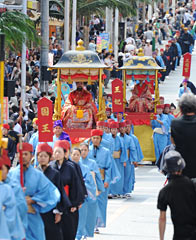
October 31, 2011 Ryukyu Shimpo
In the afternoon of October 30, the third day of the Shurijo Castle Festival, a Royal Procession replicating a scene on a Ryukyu Dynasty picture scroll was held in Kokusai Street in Naha. The splendor and beauty of the parade fascinated local people and tourists alike.
About nine hundred people in colorful Ryukyuan traditional costume participated in the procession, parading to the beat of a gong and a tune played on a flute.
As he watched the procession go by, 37 year-old woman, who was visiting from France with his family, said, “I have seen several major Japanese festivals, but this parade is really worth seeing because mainland Chinese culture is also mixed in.”
On November 3, a ceremony featuring the “king” and “queen” will be held at the seiden of Shurijo Castle from 12:50pm, and then from 2:00pm the koshiki gyoretsu (traditional procession) will go as far as the Torihori intersection.
(English translation by T&CT, Lima Tokumori and Mark Ealey)
Go To Japanese

Go To Video1

Go To Video2
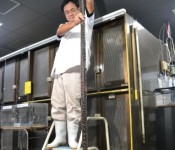
November 1, 2011 Ryukyu Shimpo
On October 31, the Okinawa Prefectural Institute of Health and Environment in the city of Nanjo put the world’s longest habu on display to the public. It is 2.42 meters long and weighs around 2.9 kilograms.
The previous record was 2.41 meters for a specimen found in September 1992 on Amami-Oshima Island (Kagoshima Prefecture) north of Okinawa.
Okinawa Prefecture’s longest habu previously recorded was 2.25 meters in length, and was found in Itoman City in November 2005.
The Institute intends to stuff the venomous indigenous snake so it can be put on permanent display.
This habu was spotted on a road in the village of Onna, before being captured and killed by local residents, on October 12.
The average length of habu snakes is 1.3 meters, but Koki Terada, a researcher at the Institute said, “A habitat rich in sources of food is likely to have contributed to this snake having grown to such a length.”
In Okinawa, many people are bitten by habu every year during the period from September to November, and Terada issued a warning to the public, saying, “Habu live in areas populated by humans and are nocturnal, so people really do need to take care.”
(English Translation by T&CT, Mark Ealey)
Go To Japanese
October 25, 2011 Ryukyu Shimpo
By October 24, a worker carrying out a magnetic survey in farmland in Kuniyoshi Ward in Itoman City as part of the nation’s broad-scale excavation project had found approximately 100 items of unexploded ordnance thought to be from the former Imperial Japanese Army in the Battle of Okinawa. There were also three human bones found near the farmland. The ordnance has been stored at the scene because it is in an advanced stage of rusting away and therefore it is thought it pose a low-risk of explosion.
The worker found 12 hand grenades, 94 bullets, three human bones, and what is thought to be a Japanese soldier’s helmet, canteen and seal. It is not known if fuses are in the grenades, which together with the ammunition will be disposed of in the days ahead.
According to people involved, the items were found within an area five meters square. They found the human bones at a depth of about two meters on October 23, and when they continued digging, by October 24, they had found the unexploded grenades and bullets at a depth of about three meters. It is reported that most of the personal effects discovered have been badly damaged by rust.
A large of number of unexploded shells have been found in Maezato Ward of Itoman City, including 902 shells in July 2010 and another 2113 two months later in September.
(English Translation by T&CT, Lima Tokumori and Mark Ealey)
Go To Japanese

October 30, 2011 Rika Ishikawa of Ryukyu Shimpo
On the afternoon of October 28, the Okinawa Prefectural Performing Arts Association, or Okigeiren (chaired by Choichi Terukina), commenced its “Ryukyuan Traditional Arts – Three European Countries” tour at the Japan Cultural Institute in Paris, a city known for its history and culture. A total of 18 Okinawan performers, including some designated as “Important Intangible Cultural Property” in kumiodori traditional Okinawan musicals, and several talented young performers, enthralled the audience with some marvelous examples of Ryukyuan traditional performing arts.
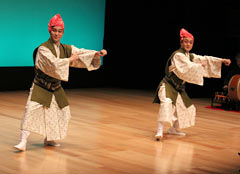
On October 29, on the second day of the Okigeiren European tour, the Hatoma bushi performance was well received by the audience at the Japan Cultural Institute in Paris.
This is the first overseas tour for those involved with
kumiodori since its registration with the UNESCO as an example of “Intangible Cultural Heritage.” In the first part of the program, five acts of
ryubu or Ryukyuan classical dance and solo Ryukyuan classical music were performed, with the second part featuring the
kumiodori play
Nidou tekiuchi (trans: Revenge for two children).
The many French people in the audience who were experiencing Ryukyuan Performing Arts for the first time were drawn into a unique world centered on ryubu. In the Ryukyuan classical music solo performance, the mature vocals of “national treasure” Choichi Terukina earned generous applause from the audience.
In the kumiodori play Nidou tekiuchi, veteran and young performers demonstrated the full range of their ability in the sorrowful parting of the mother and her children, and the tense scene of revenge and the venue echoed with applause when the show came to an end.
Resident of Paris Edith Lagarde said, “I was fascinated by the beautiful scenes performed on stage. The commentary provided allowed us to easily enter the world of kumiodori, and as a result, to thorough enjoy the experience.” Terukina, who is also the principal of the troupe said, “We are filled with both joy and gratitude at having been able to bring Okinawan traditional performing arts to France. To be honest, we were quite worried about performing overseas, but the response of the audiences here has reassured us.”
The Kumiodori European Tour performances were held in France, in afternoon and evening of October 29, in Cologne, Germany on October 31 and in Rome, Italy, November 2.
(English Translation by T&CT, Mark Ealey)
Go To Japanese
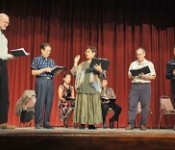
October 28, 2011 Kazuki Furugen of Ryukyu Shimpo
A play written by Tatsuhiro Oshiro entitled The Cocktail Party had its premiere on October 26 at the Hawaii Okinawa Center (Waipahu, Hawaii). Tatsuhiro Oshiro is the first author from Okinawa to be awarded the prestigious Japanese literary award, the Akutagawa Prize. Performed in English in front of an audience of more than 300 people, the play is the stage performance version of the novel The Cocktail Party. Touching on Japan’s attack on Pearl Harbor, the story portrays both Japan and the United States as aggressors in World War II. The play was performed by a local drama group, the Manoa Readers/Theatre Ensemble.
The president of the United Japanese Society of Hawaii, 55 year-old third generation Okinawan David Zen-Yu Arakawa emphasized, “The writer is courageous in raising such a difficult but important issue. The play focuses on the struggle to come to terms with being both a victim and a victimizer, and how to reconcile these two different points of view. I was impressed that it finished by expressing the hope that reconciliation is possible.”
Award winner Oshiro commented, “It was very well presented, using just the actors’ lines and facial expressions. I would like many more Americans to see this play, but I do think that it premiering like this in a multi-ethnic immigrant society such as Hawaii has particular significance.”
A second performance was held at the University of Hawaii at Manoa on October 27.
(English Translation by T&CT, Megumi Chibana and Mark Ealey)
Go To Japanese
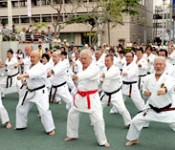
October 26, 2011 Ryukyu Shimpo
On October 25, the Society for the Advancement of Traditional Okinawa Karate had a special demonstration for the first time on Karate Day. It was held in front of Palette Kumoji, a department store in Naha, to demonstrate karate to people from both inside and outside of the prefecture.
Fifty representatives from four organizations – All Okinawa Karate-do Federation, Okinawa Prefectural Karate-do Federation, Okinawa Karate and Kobudo Federation, and Okinawa Karate Association – performed karate kata such as seisan and sanchin. All board members also gave a well-coordinated performance of chudan zuki.
Governor Hirokazu Nakaima and Mayor of Naha City Takeshi Onaga joined in the event wearing karate uniforms. Governor Nakaima also serves as the chairman of the Society said, “Karate has been introduced to over 180 countries and now has 50 million exponents around the world. Let’s work together to spread the appeal of karate.”
One of the performers of the Okinawa Karate and Kobudo Federation, 27 year-old Akina Tamaki from Urasoe City stated, “I hope that this demonstration leads to an increase in the number of people who love karate.”
(English Translation by T&CT, Shinako Oyakawa and Mark Ealey)
Go To Japanese

Go To Video
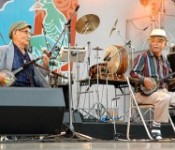
October 25, 2011 Kaori Tamashiro and Naoki Isa of Ryukyu Shimpo
On October 23, the Ryukyu Festival 2011, the biggest Okinawan music event of its kind, was held by FM OSAKA at the Oska Castle Bandshell in Osaka. A total of 17 groups or individuals participated in the festival, including established musicians Seijin Noborikawa and Sadao China, plus debutante Erika Sunagawa.
About 2000 people danced the kachashi to the tune of shima uta. Noborikawa enthralled the audience with his easy talking style and superb singing voice. Sunagawa sang Hitotsubu no tane with Isamu Shimoji, who wrote the music for the song, bringing an air of tranquility to the venue. Parsha cluB, headed by Yukito Ara, stated, “We wish Osaka, Okinawa and East Japan the best of luck!” and played Gokoku hojo (“A rich harvest”), which really got the audience going. At the end of festival, after the all performers played the song Honen ondo, the event closed with Tsuki nu kaisha, sung by four singers including Rimi Natsukawa.
(English Translation by T&CT, Lima Tokumori and Mark Ealey)
Go To Japanese
Looking back on the day in which the streets of Osaka rang with Okinawan music(taken by Kaori Tamashiro)
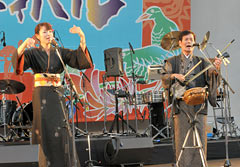
Shunzo Tsukiji (right) from Amami Island impressed the audience with his playing three roles of drum, sanshin and singer with Saori Kawabata.
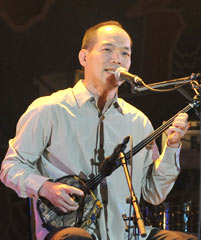
Yasukatsu Oshima held the audience spellbound singing a Yaeyama folk-song in his deep voice.
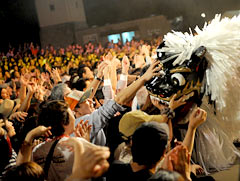
Shishi lion of Uruma-goten in Osaka snapping at the audience.
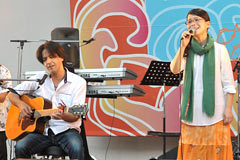
Erika Sunagawa (right) sang <em>Hitotsubu no tane</em> with Isamu Shimoji, the composer of the song.
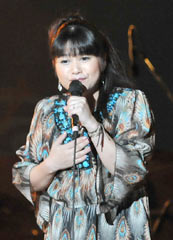
Rimi Natsukawa passionately sings Nadasoso.
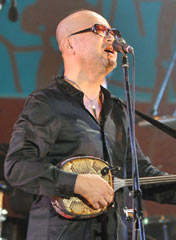
Yukito Ara of Parsha cluB impressed the audience with his excellent performance.
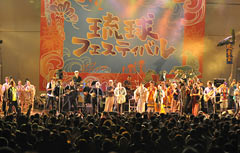
About 2000 people were fascinated by Okinawan music at the Ryukyu Festival 2011, on October 23 at the Osaka Castle Bandshell.

October 25, 2011 Ryukyu Shimpo
The Okinawa Prefectural Bullfighting Federation (Chairman Masakazu Kochi) recently decided upon a logo. In a competition organized by the Federation and the Ryukyu Shimpo, a logo designed by 35 year-old company employee and resident of Nakagusuku Village Tomokazu Yasuda was selected from among the total of 53 works put forward by members of the public for consideration.
Yasuda chose to depict a scene in which two bulls have their horns firmly interlocked. Clearly delighted to receive the award, he said, “I tried to create a simple design to convey the essence of bullfighting.” Masakazu Kochi, the chairman for the federation said, “We are thrilled to be able to select such a marvelous design. We will use this from now in the Federation’s activities.”
The award ceremony will be carried out at the All Okinawa Togyu (Bullfighting) Autumn Tournament, scheduled to be held on November 13 at Ishikawa Municipal Multipurpose Dome in Uruma City.
(English Translation by T&CT, Mark Ealey)
Go To Japanese
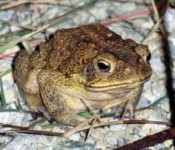
October 24, 2011 Ryukyu Shimpo
Cane toads, which are designated as an invasive alien species due to their harmful effect on the ecosystem, have been identified and captured on a regular basis in Urasoe City. According to the Ministry of the Environment Naha Nature Conservation Office, 550 of these toads have been trapped in U.S. Marine Corps Camp Kinser, and 50 in Minatogawa within Urasoe City itself. The U.S. Marine Corps Okinawa has worked on pest control and the city has urged its citizen to cooperate in the process of finding and catching these toads by distributing leaflets. Cane toads measure about 8 to 20 centimeters in length, and are a variety of large toad originating in Central and South America. The intrusion route to the main island of Okinawa remains unknown, but cane toads have already colonized North and South Daito Islands and Ishigaki Island. The breeding season next spring brings with it the threat of an explosion in the population of these animals. If you manage to capture one, put it in a plastic bag to stop it escaping and contact the Ministry of the Environment Naha Nature Conservation Office (098-858-5824) or the Environmental Conservation Section of Urasoe City (098-876-1234 ext. 3216).
(English Translation by T&CT, Shinako Oyakawa and Mark Ealey)
Go To Japanese
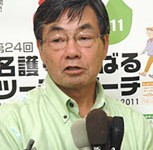
October 26, 2011 Ryukyu Shimpo
Nago Mayor says, “The evaluation report has no meaning”
With regard to the defense ministers’ meeting of Yasuo Ichikawa and Leon E. Panetta, in which the relocation of the U.S. Marine Corps Futenma Air Station to Henoko in Nago City and the environmental impact statement to be submitted later in the year was agreed upon, Nago City Mayor Susumu Inamine held a press conference on October 25, in which he indicated his strong discomfort, saying, “The current environment in Okinawa will not allow this [both governments’ policy on the Futenma relocation to Henoko.]”
Mayor Inamine said, “There is no way that both governments can implement the Japan-U.S. agreement by just ignoring local residents’ opposition to it.” He went on to criticize both governments, saying, “There is no consensus among the people of Okinawa Prefecture to accept the relocation plan. Does the government intend to use force to make it happen?”
“Many issues have already been pointed out about the document that defines the scope of the environmental impact assessment and its preparatory documents. I wonder about what sort of evaluation report will be produced here?” he said skeptically, adding a warning that, “A report issued in this manner by the government will be given no credence, and will have no meaning.”
Ginowan City Official says, “We want the governments to understand the reality of the situation around the Futenma Air Station”
Shigeo Yamauchi, the director of the Base Policy Division for Ginowan City said, “The majority of Okinawan people oppose the Henoko relocation plan so it is impossible to carry it out. Both governments should strive to understand the realities surrounding the Futenma issue and should amend their agreement and look for somewhere overseas as the place for relocation.” With regard to the current situation in the prefecture, he said, “If the government is too heavy-handed with the Okinawan people on this issue it will trigger an even stronger reaction among local residents. We are concerned that the way things are going the base at Futenma will end up staying where it is. I want both the Japanese and United States governments to come to grips with the reality of the situation surrounding Futenma.”
(English Translation by T&CT, Mark Ealey)
Go To Japanese
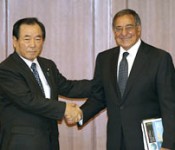
October 26, 2011 Ryukyu Shimpo
On October 25, one after another, Prime Minister Yoshihiko Noda, Foreign Minister Koichiro Gemba and Defense Minister Yasuo Ichikawa met with U.S. Defense Secretary Leon E. Panetta in Tokyo. They explained to him that the Japanese government will submit to Okinawa Prefectural Government the evaluation report of the environmental impact assessment of the relocation of the U.S. Marine Corps Futenma Air Station to Henoko in Nago City, and agreed that it is important for Japan and United States to move forward with the relocation of Futenma Air Station as soon as possible.
With regard to the procedure from this point on, including the application to obtain approval from the Okinawa Prefectural Governor for the landfill needed for the Henoko relocation, in the joint press conference Secretary Panetta said it should be done “as soon as possible,” and he urged Japan to move ahead with the necessary procedures for the landfill.
In his joint press conference after meeting with Defense Minister Ichikawa, with regard to the Japanese government’s intention to submit the environmental impact statement later this year, Secretary Panetta said, “I was very pleased with the comments of the minister as well as the prime minister and the foreign minister as well, all of whom confirmed that they were working to be able to present their environmental impact statement before the end of this year.”
At the same time, he emphasized that his government will make efforts to move forward with the relocation of about 8000 U.S. Marines who are currently in Okinawa to Guam, something that is integrated with the relocation plan of the facilities and personnel at Futenma.
(English Translation by T&CT, Mark Ealey)
Go To Japanese





















 Webcam(Kokusai Street)
Webcam(Kokusai Street)


